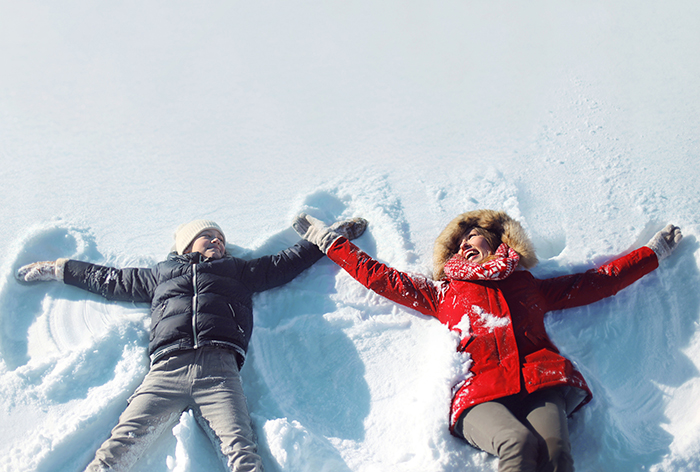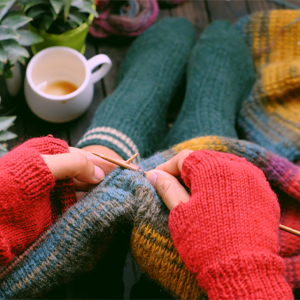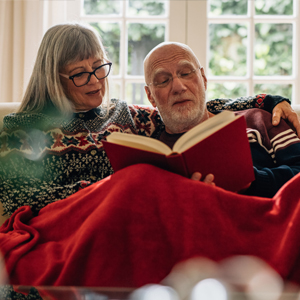Escape screen time this winter
Posted on November 25, 2020 at 6:00 am

BY MELISSA RHOADES
Several excellent virtual library programs are happening this winter, and we hope to see you at them! We also hope you’re taking breaks from screen time—especially if you’re one of the many people currently working, socializing, and playing virtually these days.
Screen time is any time spent in front of a television, tablet, computer, smart phone, or gaming device.
A lot has been written about the negative effects of screen time for children and adolescents, and excessive screen time impacts adults too, including increased risks of:
- Headaches and back pain
- Eyestrain
- Weight issues
- Sleep disturbances
- Mental health issues, including depression
- Relationship problems
- Type 2 diabetes
- Cardiovascular disease
A 2019 article published by the Mayo Clinic recommends the following “acceptable” daily amounts of screen time:
- No screen time for children under 2 years old
- One hour per day for children aged 2–12
- Two hours per day for teens and adults
For those of us who use computers at work and/or school, two hours per day is an impossible standard to achieve. In fact, in 2019—before the pandemic increased virtual socializing—daily screen times already averaged 7–10 hours a day per person.
With evermore activities turning virtual these days, is it even possible to maintain leisure activities away from screens? Yes, it is!
Here are some (mostly free) activities that will get you ditching screens and avoiding cabin fever this winter.

Head outdoors
Outdoor activities are one of the best ways to get away from screens and also one of the safest ways to recreate during the pandemic. So bundle up and venture outdoors with a thermos of your favorite hot beverage.
If there’s snow, head to your yard or a local park for free sledding, snow sculptures, snowball fights, and more. If you want a more low-key activity, plan a winter walk somewhere you haven’t been for a while (different neighborhood, local trail, or a park across town). Just be sure to verify that your destination has safe winter access before you head out.
Mount Spokane State Park, Riverside State Park, Spokane River Centennial State Park Trail, and the Columbia Plateau State Park Trail are all open throughout the winter for snow play and winter sports. Best yet, Washington State Park Discover Passes (required for parking at State Parks) are available for a free seven-day checkout with a valid library card. Just place the pass on hold, and once it’s available, collect it via curbside pickup.
For an urban winter walk, you can head to Riverfront Park in downtown Spokane where you’ll find a free light show at the U.S. Pavilion every Friday, Saturday, and Sunday from sunset to 10pm.

Explore with Parks & Recreation
The city of Spokane is offering in-person as well as virtual programming this fall and winter. In-person programs include indoor and outdoor options that comply with Washington State’s Phase 2 COVID-19 safety precautions.
Indoor classes include painting, drawing, photography, jewelry making, and more. Fall outdoor options include hiking, snowshoeing, and recreational therapy. Winter outdoor options generally include skiing classes too. Parks & Rec programs tend to be modestly priced and provide a big bang for your buck! Some programs even supply the required sports equipment (snowshoes, skis, etc.) as well as instruction, so you don’t need any prior skills or equipment to participate.
See Spokane Parks and Recreation’s most recent Activity Guide for class offerings and specific information.

Tap into your creative side
You don’t have to pay for classes to learn a new art or craft. The library offers hundreds of how-to books on just about everything: painting, drawing, wood carving, crochet, knitting, and more.
And while most art forms require some specialty supplies, being creative doesn’t need to cost any money at all! The new book You Are an Artist: Assignments to Spark Creation, by Sarah Urist Green, includes ideas that don’t require anything other than items already lying around your house. Written by the creator of PBS’s The Art Assignment, You Are an Artist offers a screen-less option to “participate in the building of a new, more democratic art world of our own making.”

Connect (or reconnect) with music
If you’re like me, music was a huge deal when you were a kid.
As a child, I spent countless hours lying on the floor just listening to albums. Really listening. Today, there are several ways to stream music for free if you have an internet connection, including hoopla with your in-district library card.
For those who have stereo equipment, the library offers over 8,000 music CDs, including rock, pop, rap, jazz, classical, folk, and more. So take a break from your screens, from multi-tasking, and let music come into the foreground for a change. And for times when you’re not in the mood to be still, dance around the living room. Even better, work up some choreography and make your own TikTok video—a perfect way to combine screen time and non-screen time.

Cook up a storm
The kitchen can be a magical place where creativity meets practicality.
If you’ve never cooked before, this winter is a perfect time to start with the help of basic cooking guides and other books on cooking basics.
If you’re already conversant in the kitchen, branch out into a new type of cuisine. Have you tried Persian food? Or Amish recipes? How about cuisine inspired by indigenous American ingredients and traditions? For old-fashioned swank, impress your family with French cooking, or expand your palette to vegetarian options.
Browse our online catalog to find recipes from dozens of international food traditions as well as new, innovative techniques.

Expand your fitness regime
Do you have limitations that seem to exclude you from fitness? Or are you stuck in the same old fitness rut?
Let the library help you find a new type of exercise to spark or re-spark your physical wellbeing. Check out free book and DVD instructions for gentle chair yoga and senior fitness or Capoeira and martial arts and even sports you can do with your dog. You’ll find dance instruction options that include cardio dance, ballet instruction, belly dance, and more.
While it’s true that instructional videos require some screen time, they also get you moving around and help you avoid being sedentary. It’s also relatively easy to give your eyes breaks from the screen as you put into practice what you’re learning.

Watch for the possibility of a free museum visit
Due to current pandemic restrictions, the Northwest Museum of Arts & Culture (MAC) has had to close its doors until at least December 15.
Once the museum is allowed to reopen, MAC Museum Passes from the library will once again be available for check out for library customers with in-district library cards. You can check out one pass per year, available first-come, first serve through our online booking system. Passes can be reserved up to 30 days in advance, and each pass provides admission for up to two adults and four children.
Current MAC exhibits include a Pop Art exhibit (through January 24), a tribute to 75 years of the Spokane Symphony (through January 10), and two World War II exhibits (through May 23). Upcoming exhibits include Witness to Wartime: The Painted Diary of Takuichi Fujii (January 23–May 16) and Dressing the Abbey: The Costumes of Downton Abbey™ (February 6–May 2).

Read print books—at least part of the time
According to the American Academy of Ophthalmology (AAO), electronic screens strain our eyes more than print materials because we blink less often when we look at screens. The 2019 article Protect Your Eyes from Too Much Screen Time explains that “Focusing the eyes on computer screens or other digital displays has been shown to reduce a person’s blink rate by a third to a half, which tends to dry out the eyes. We also tend to view digital devices at less than ideal distances or angles.”
Furthermore, a 2014–2015 clinical study found that using an e-reader at night reduces melatonin secretion and alters circadian rhythms, negatively affecting quality of sleep and next-day alertness.
With curbside pickup, you can stock up on print materials and audiobooks on CD from the library. Get started with our online catalog, or call 509.893.8400 for help searching for titles.
For bookworms who prefer reading via the Digital Library, try switching to audiobooks and podcasts at least one hour before bedtime. The library offers digital audiobooks through OverDrive and hoopla.
And for all of us, no matter when we’re using screens, here are some tips from the AAO for avoiding eyestrain:
- Keep your monitor or screen at arm’s length (about 25 inches away).
- Position the screen so your eye gaze is slightly downward.
- Use a matte screen filter to reduce glare.
- Adjust lighting: If a screen is brighter than the surrounding light, your eyes have to work harder to see. Adjust your room lighting and increase the contrast on your screen to reduce eye strain.
- Blink often and follow the 20-20-20 rule: every 20 minutes look at an object 20 feet away for 20 seconds. Looking into the distance allows your eyes to relax.
- Keep eyes moist: Artificial tears and desk-top humidifiers can help keep your eyes lubricated.
- Use nighttime settings on devices after dark. These help minimize blue light exposure in the evening.
- Stop using screen devices 1–2 hours before bed.
Let us know how you’re escaping screen time. Share your screen-free activities in the comments section.

Tags: adults, art, books, concerns, cooking, crafts, dance, exercise, health, hiking, hobbies, issues, music, outdoors, screen time, skiing, snow
